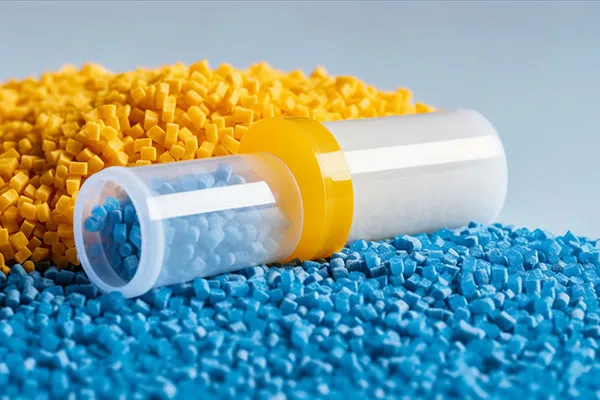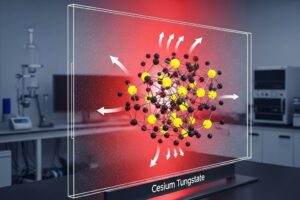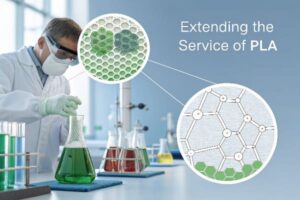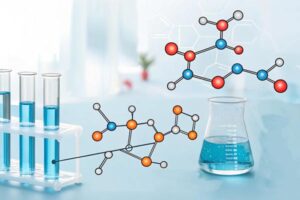In the field of polyester modification—particularly when working with materials such as PLA (polylactic acid), PET, and rPET—chain extenders are vital additives used to improve melt strength, molecular weight, and overall processability. Two popular types of chain extenders are PMDA (pyromellitic dianhydride) and epoxy-functional chain extenders, such as HyMax® KL-180.
Although both aim to achieve similar goals in terms of enhancing rheological properties, they differ significantly in reactivity, reaction mechanism, effectiveness in viscosity control, and toxicity. Understanding these differences is critical when selecting the right chain extender for your formulation.
1. Reactivity: PMDA is Aggressive, HyMax KL-180 is More Controllable
PMDA – High Reactivity and Fast Action
PMDA contains two anhydride groups that are extremely reactive, especially with hydroxyl end groups (–OH) on polyester chains. At typical processing temperatures (180–220°C), these groups open rapidly and form new ester bonds, creating branching or even crosslinked structures.
This makes PMDA highly effective for rapid viscosity build-up, but also risky in terms of over-crosslinking or gel formation if not properly dosed or controlled. Small variations in processing conditions can lead to poor melt uniformity, inconsistent flow, or even blocked extruders.
HyMax® KL-180 – Controlled Chain Extension with Stability
HyMax KL-180 is a multifunctional epoxy-based chain extender, containing multiple epoxy groups that react primarily with carboxyl (–COOH) and, to a lesser extent, hydroxyl and amino (–NH₂) end groups.
Its moderate reactivity provides a smooth and controlled chain extension process, making it suitable for continuous operations like extrusion, foam molding, and thermoforming. Unlike PMDA, it allows for more process flexibility and better compatibility with post-consumer recycled materials.
2. Reaction Mechanism: Anhydride vs Epoxy Chemistry
| Property | PMDA | HyMax KL-180 (Epoxy) |
| Functional group | Dianhydride | Multi-functional epoxy |
| Main reaction targets | Hydroxyl (–OH) | Carboxyl (–COOH), also –OH and –NH₂ |
| Reaction type | Ring-opening esterification, generating new –COOH groups | Epoxy ring-opening to form ester or ether bonds |
| Molecular structure effect | Strong branching or crosslinking | Linear to lightly branched chains |
PMDA is more suitable for hydroxyl-rich polymers like PLA, while HyMax KL-180 excels in carboxyl-rich systems such as recycled PET, where it reduces acid end groups and helps maintain consistent viscosity.
3. Melt Viscosity and Intrinsic Viscosity (IV) Enhancement
PMDA – Fast Viscosity Growth with Gel Risk
Due to its strong reactivity, PMDA rapidly builds molecular weight, even at low usage levels (typically 0.3–1%). This is ideal for high-viscosity applications, such as PET sheet extrusion or PLA for injection molding.
However, the downside is the risk of gelling or excessive branching, which can lead to uneven melt flow, surface defects, and challenging extrusion conditions.
HyMax KL-180 – Smooth and Stable Viscosity Control
HyMax KL-180 provides a gradual and consistent increase in molecular weight, enabling fine-tuned melt strength improvement without causing gels. It is ideal for:
PLA foam extrusion (improved bubble stability)
rPET thermoforming sheets (stable IV and clarity)
Blown film and profile extrusion
Its performance is more predictable across a wider range of processing conditions, making it favored in high-throughput or heat-sensitive applications.
4. Toxicity and Handling: A Key Safety Consideration
PMDA – Higher Toxicity, Stricter Handling Required
PMDA is classified as a hazardous substance under various chemical safety regulations. According to the EU CLP classification, it carries several hazard statements:
H315 – Causes skin irritation
H319 – Causes serious eye irritation
H334 – May cause allergy or asthma symptoms
Workers handling PMDA must use personal protective equipment (PPE) including gloves, masks, and proper ventilation systems. Even trace exposure can cause sensitization over time.
HyMax KL-180 – Safer for Operators and Food-Contact Applications
HyMax KL-180 is a high-molecular-weight epoxy copolymer that is non-volatile and exhibits a low toxicity profile, making it safer to handle during processing. It poses minimal inhalation or sensitization risks compared to more reactive alternatives like PMDA. While standard PPE (gloves, goggles) is still recommended, the product’s formulation aligns well with modern safety standards.
Importantly, HyMax KL-180 has passed food-contact compliance testing according to EU Regulation No. 10/2011, making it a suitable choice for applications involving direct food or skin contact, such as rPET packaging, thermoformed containers, or biodegradable food service products.
5. Application Scenarios: Which One Should You Choose?
| Use Case | Recommended Chain Extender |
| Rapid IV boosting | PMDA or HyMax KL-180 |
| Melt strength improvement for foaming or thermoforming | HyMax KL-180 |
| PLA injection molding | Both, depending on gel tolerance |
| rPET sheet extrusion | HyMax KL-180 |
| Safety-critical or food/skin-contact products | HyMax KL-180 |
If your application requires fast molecular weight increase in a tightly controlled batch process, PMDA may be suitable—provided you can manage its toxicity and gel risk. For safer, scalable, and more consistent performance, especially in modern recycling or biodegradable applications, HyMax KL-180 is the better choice.
Conclusion: PMDA vs HyMax KL-180 – Which Wins?
Both PMDA and HyMax KL-180 are powerful tools in polyester chain extension. However:
PMDA offers fast, powerful viscosity enhancement at the cost of higher toxicity and potential instability.
HyMax KL-180 provides a safer, more controllable, and versatile solution, suitable for modern trends such as sustainability, recycling, and food-grade polymer applications.
When selecting a chain extender, always consider your resin type, processing method, final application, and safety requirements. A well-informed decision can greatly impact the quality, cost-efficiency, and sustainability of your product.







